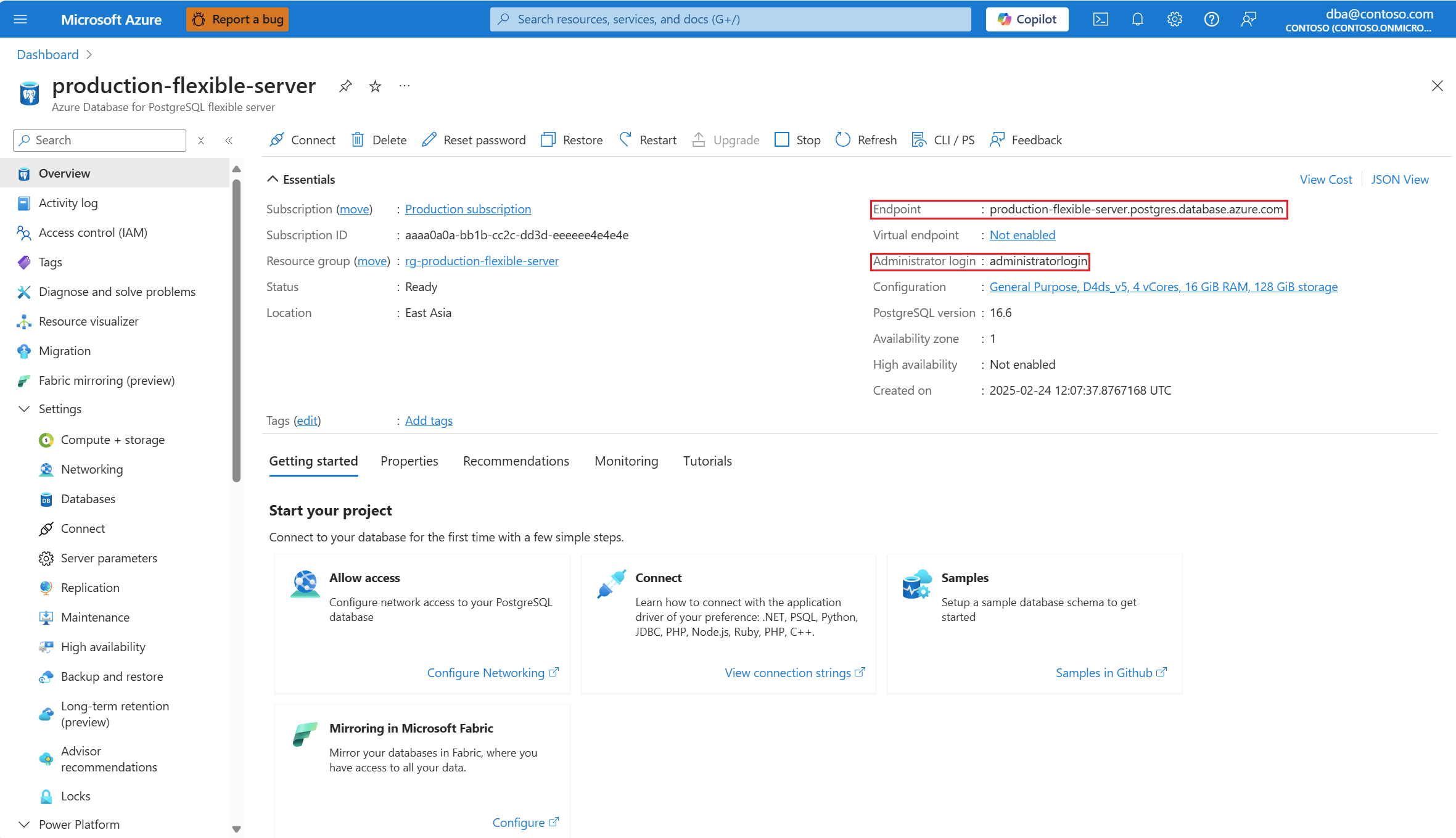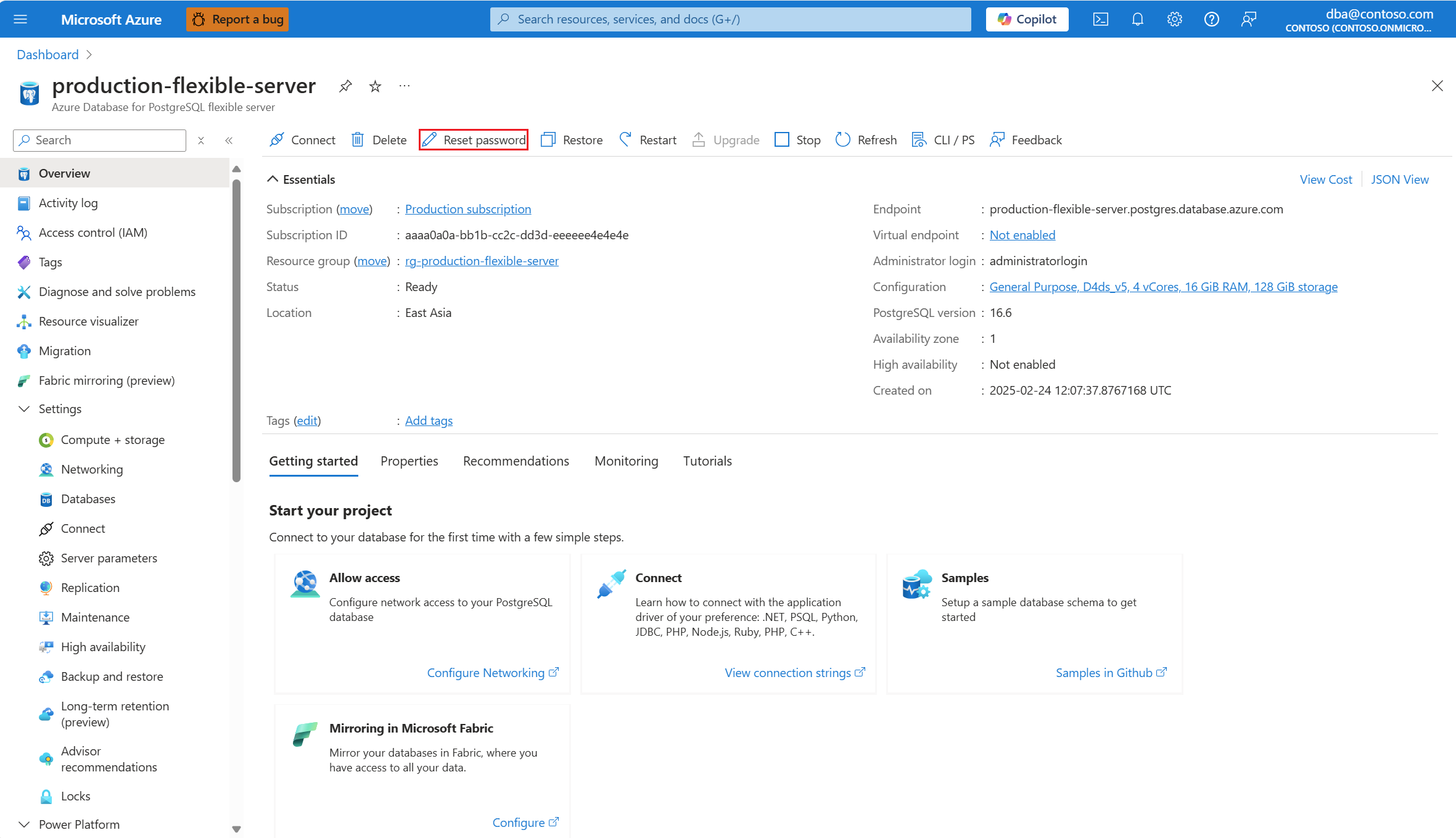本快速入门演示如何使用 C# 应用程序连接到 Azure Database for PostgreSQL 灵活服务器实例。 同时还介绍了如何使用 SQL 语句在数据库中查询、插入、更新和删除数据。 本文中的步骤假定你熟悉 C# 开发,但对 Azure Database for PostgreSQL 还是新手。
先决条件
对于本快速入门,你需要:
- 具有活动订阅的 Azure 帐户。 创建试用帐户。
- 创建一个 Azure Database for PostgreSQL 灵活服务器实例,如果您还没有的话。
- 使用服务器上可用的空 postgres 数据库,或创建新数据库。
- 请为您的平台(Windows、Ubuntu Linux 或 macOS)安装适用于该平台的.NET SDK。
- 安装 Visual Studio 以生成项目。
- 在 Visual Studio 中安装 Npgsql NuGet 包。
获取连接信息
获取连接到 Azure Database for PostgreSQL 灵活服务器实例所需的连接信息。 您需要完整限定的服务器名称和登录凭据。
使用 Azure 门户:
在 Azure 门户的左侧菜单中单击“所有资源”,然后搜索所创建的服务器。
单击服务器名称。
在资源菜单中,选择“概述”。
复制显示为终结点和管理员登录名的值。
如果忘记了“管理员登录名”的密码,可以使用“重置密码”按钮重置密码。
步骤 1:连接并插入数据
通过以下代码进行连接,然后使用 CREATE TABLE 和 INSERT INTO SQL 语句加载数据。 代码使用 NpgsqlCommand 类和以下方法:
- Open() 建立与 Azure Database for PostgreSQL 灵活服务器数据库的连接。
- CreateCommand(),用于设置 CommandText 属性。
- ExecuteNonQuery() 方法,用于运行数据库命令。
重要
将 Host、DBName、User 和 Password 参数替换为创建服务器和数据库时指定的值。
using System;
using Npgsql;
namespace Driver
{
public class AzurePostgresCreate
{
// Obtain connection string information from the portal
//
private static string Host = "mydemoserver.postgres.database.chinacloudapi.cn";
private static string User = "mylogin";
private static string DBname = "postgres";
private static string Password = "<server_admin_password>";
private static string Port = "5432";
static void Main(string[] args)
{
// Build connection string using parameters from portal
//
string connString =
String.Format(
"Server={0};Username={1};Database={2};Port={3};Password={4};SSLMode=Prefer",
Host,
User,
DBname,
Port,
Password);
using (var conn = new NpgsqlConnection(connString))
{
Console.Out.WriteLine("Opening connection");
conn.Open();
using (var command = new NpgsqlCommand("DROP TABLE IF EXISTS inventory", conn))
{
command.ExecuteNonQuery();
Console.Out.WriteLine("Finished dropping table (if existed)");
}
using (var command = new NpgsqlCommand("CREATE TABLE inventory(id serial PRIMARY KEY, name VARCHAR(50), quantity INTEGER)", conn))
{
command.ExecuteNonQuery();
Console.Out.WriteLine("Finished creating table");
}
using (var command = new NpgsqlCommand("INSERT INTO inventory (name, quantity) VALUES (@n1, @q1), (@n2, @q2), (@n3, @q3)", conn))
{
command.Parameters.AddWithValue("n1", "banana");
command.Parameters.AddWithValue("q1", 150);
command.Parameters.AddWithValue("n2", "orange");
command.Parameters.AddWithValue("q2", 154);
command.Parameters.AddWithValue("n3", "apple");
command.Parameters.AddWithValue("q3", 100);
int nRows = command.ExecuteNonQuery();
Console.Out.WriteLine(String.Format("Number of rows inserted={0}", nRows));
}
}
Console.WriteLine("Press RETURN to exit");
Console.ReadLine();
}
}
}
步骤 2:读取数据
使用以下代码进行连接,并使用 SELECT SQL 语句来读取数据。 代码使用 NpgsqlCommand 类和以下方法:
- Open(),用于与 PostgreSQL 建立连接。
- CreateCommand() 和 ExecuteReader(),用于运行数据库命令。
- Read(),用于转到结果中的记录。
- GetInt32() 和 GetString(),用于分析记录中的值。
重要
将 Host、DBName、User 和 Password 参数替换为创建服务器和数据库时指定的值。
using System;
using Npgsql;
namespace Driver
{
public class AzurePostgresRead
{
// Obtain connection string information from the portal
//
private static string Host = "mydemoserver.postgres.database.chinacloudapi.cn";
private static string User = "mylogin";
private static string DBname = "postgres";
private static string Password = "<server_admin_password>";
private static string Port = "5432";
static void Main(string[] args)
{
// Build connection string using parameters from portal
//
string connString =
String.Format(
"Server={0}; User Id={1}; Database={2}; Port={3}; Password={4};SSLMode=Prefer",
Host,
User,
DBname,
Port,
Password);
using (var conn = new NpgsqlConnection(connString))
{
Console.Out.WriteLine("Opening connection");
conn.Open();
using (var command = new NpgsqlCommand("SELECT * FROM inventory", conn))
{
var reader = command.ExecuteReader();
while (reader.Read())
{
Console.WriteLine(
string.Format(
"Reading from table=({0}, {1}, {2})",
reader.GetInt32(0).ToString(),
reader.GetString(1),
reader.GetInt32(2).ToString()
)
);
}
reader.Close();
}
}
Console.WriteLine("Press RETURN to exit");
Console.ReadLine();
}
}
}
步骤 3:更新数据
使用以下代码进行连接,并使用 UPDATE SQL 语句更新数据。 代码使用 NpgsqlCommand 类和以下方法:
- Open() 建立与 Azure Database for PostgreSQL 灵活服务器实例的连接。
- CreateCommand(),用于设置 CommandText 属性。
- ExecuteNonQuery() 方法,用于运行数据库命令。
重要
将 Host、DBName、User 和 Password 参数替换为创建服务器和数据库时指定的值。
using System;
using Npgsql;
namespace Driver
{
public class AzurePostgresUpdate
{
// Obtain connection string information from the portal
//
private static string Host = "mydemoserver.postgres.database.chinacloudapi.cn";
private static string User = "mylogin";
private static string DBname = "postgres";
private static string Password = "<server_admin_password>";
private static string Port = "5432";
static void Main(string[] args)
{
// Build connection string using parameters from portal
//
string connString =
String.Format(
"Server={0}; User Id={1}; Database={2}; Port={3}; Password={4};SSLMode=Prefer",
Host,
User,
DBname,
Port,
Password);
using (var conn = new NpgsqlConnection(connString))
{
Console.Out.WriteLine("Opening connection");
conn.Open();
using (var command = new NpgsqlCommand("UPDATE inventory SET quantity = @q WHERE name = @n", conn))
{
command.Parameters.AddWithValue("n", "banana");
command.Parameters.AddWithValue("q", 200);
int nRows = command.ExecuteNonQuery();
Console.Out.WriteLine(String.Format("Number of rows updated={0}", nRows));
}
}
Console.WriteLine("Press RETURN to exit");
Console.ReadLine();
}
}
}
步骤 4:删除数据
使用以下代码进行连接,并使用 DELETE SQL 语句删除数据。
该代码使用 Open() 方法和 NpgsqlCommand 类建立与 Azure Database for PostgreSQL 灵活服务器数据库的连接。 然后,代码使用 CreateCommand() 方法,设置 CommandText 属性,再调用 ExecuteNonQuery() 方法来运行数据库命令。
重要
将 Host、DBName、User 和 Password 参数替换为创建服务器和数据库时指定的值。
using System;
using Npgsql;
namespace Driver
{
public class AzurePostgresDelete
{
// Obtain connection string information from the portal
//
private static string Host = "mydemoserver.postgres.database.chinacloudapi.cn";
private static string User = "mylogin@mydemoserver";
private static string DBname = "postgres";
private static string Password = "<server_admin_password>";
private static string Port = "5432";
static void Main(string[] args)
{
// Build connection string using parameters from portal
//
string connString =
String.Format(
"Server={0}; User Id={1}; Database={2}; Port={3}; Password={4};SSLMode=Prefer",
Host,
User,
DBname,
Port,
Password);
using (var conn = new NpgsqlConnection(connString))
{
Console.Out.WriteLine("Opening connection");
conn.Open();
using (var command = new NpgsqlCommand("DELETE FROM inventory WHERE name = @n", conn))
{
command.Parameters.AddWithValue("n", "orange");
int nRows = command.ExecuteNonQuery();
Console.Out.WriteLine(String.Format("Number of rows deleted={0}", nRows));
}
}
Console.WriteLine("Press RETURN to exit");
Console.ReadLine();
}
}
}
清理资源
若要清理本快速入门中使用的所有资源,请使用以下命令删除该资源组:
az group delete \
--name $AZ_RESOURCE_GROUP \
--yes
相关内容
- 使用 Azure 门户管理 Azure Database for PostgreSQL。
- 快速入门:使用 Python 连接和查询 Azure Database for PostgreSQL 中的数据。
- 快速入门:将 Java 和 JDBC 与 Azure Database for PostgreSQL 配合使用。
- 快速入门:使用 Go 语言在 Azure Database for PostgreSQL 中连接和查询数据。
- 快速入门:使用 PHP 连接和查询 Azure Database for PostgreSQL 中的数据。
- 快速入门:使用 Azure Database for PostgreSQL 通过 Azure CLI 连接和查询。
- 快速入门:从 Power BI 中的 Azure Database for PostgreSQL 导入数据。


